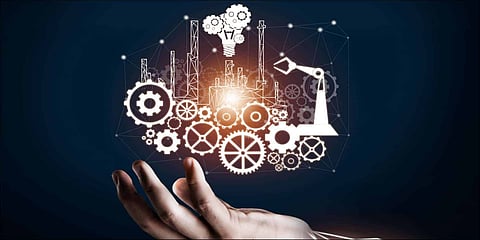

Gartner says enterprises need to deliver end-to-end automation beyond RPA by combining complementary technologies to augment business processes. To address this concern, we have an update called hyperautomation. This term first appeared in October of 2019, taking the top spot on Gartner's Top 10 Strategic Technology Trends for 2020 list. While automation uses technology to perform work that initially required human action, RPA enabled an easy transition to automation at the industry level. However, the main limitation of RPA is that it can only automate simple tasks as it works by following predefined rules with structured data.
Meanwhile hyperautomation allows enterprises to automate more complex work. It relies on powerful disruptive technologies like natural language processing (NLP), vision, speech, deep learning, reinforcement learning, predictive analytics, and more. In short, it is a combination of RPA plus artificial intelligence (AI).
So, if RPA involves rules-based coding via robots, AI is concerned with simulating human intelligence by machines. And together, they facilitate end-to-end business process automation and delivers greater impact along with people interpreting data and making decisions. Just like automation, this technology will not replace humans. Instead, humans are freed from repetitive and low-value tasks to focus on ones that are of a higher value to the organization. It will also help organizations to provide superior customer experiences while reducing operational costs and boosting profitability.
Further, it overcomes certain of the limitations of approaches that rely on a single automation tool. Thus allowing companies to move beyond the confines of individual processes and automate nearly any tedious and scalable task. Moreover, hyperautomation enables integration, scalability in operations, and encourages planning.
As mentioned earlier, hyperautomation is not the opposite of RPA. It rather validates the automation through RPA offerings besides augmenting it to show how by combining RPA, AI, ML, process mining, decision management, natural language processing (NLP), and more, companies can obtain a reliable end-to-end automation solution. It can be deemed the next investment and development source and a new avenue to deliver solutions. Additionally, as RPA is limited to structured data, hyperautomation technologies can handle structured and unstructured data. This implies that leveraging hyperautomation tools would mean powerful analytical tools and capabilities. It can also boost employee satisfaction levels by freeing them from rote tasks. Also, it can bring higher revenue with minimal inventory and reduced costs through the optimization of resources. In other words, hyperautomation can result in a transition from simple rules-based tasks to knowledge work, with a greater return on investment and more dynamic experiences. Enterprises will also be able to quickly reconfigure processes as needs evolve, requiring agile working practices and tools. So, as automation is growing and evolving as an imperative tool for businesses, hyperautomation will provide a much need momentum and transformation by targeting broader market applications.
Join our WhatsApp Channel to get the latest news, exclusives and videos on WhatsApp
_____________
Disclaimer: Analytics Insight does not provide financial advice or guidance. Also note that the cryptocurrencies mentioned/listed on the website could potentially be scams, i.e. designed to induce you to invest financial resources that may be lost forever and not be recoverable once investments are made. You are responsible for conducting your own research (DYOR) before making any investments. Read more here.
